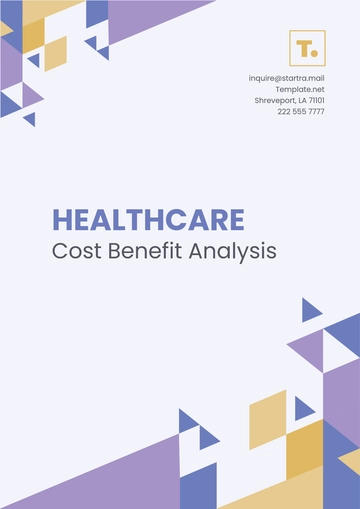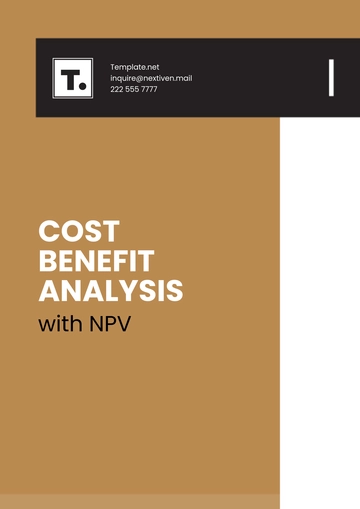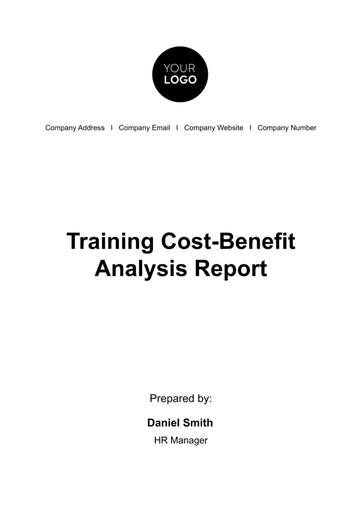Free Nursing Home Financial Analysis

Executive Summary
This financial analysis presents an overview of the financial performance of [Your Company Name] for the fiscal year ending [Date]. The analysis encompasses various aspects including revenue, expenses, profitability, cash flow, and balance sheet metrics. Key findings indicate steady revenue growth, effective expense management, and strong profitability. However, challenges related to rising operating costs and regulatory compliance are identified. Recommendations focus on optimizing revenue streams, controlling expenses, and enhancing financial resilience.
I. Introduction
A. Background of [Your Company Name]
The company you are inquiring about, [Your Company Name], was proudly established in the year [Year]. Since then, we have cemented our place as a leading light in the provision of long-term care services in the [Location] area. As a vital part of our approach to providing this top-notch care, we employ a team of healthcare professionals who are not just skilled, but also deeply dedicated to their roles and the patients they serve. They operate within our state-of-the-art facilities that have been designed and maintained to create a comfortable and helpful environment.
The driving force behind every action we take at [Your Company Name] is our commitment. It's a commitment to delivering care of the highest quality to our treasured elderly residents. More than just care, we provide support to ensure their day-to-day lives are as rewarding and fulfilling as possible.
B. Purpose and Scope of the Financial Analysis
The purpose of this financial analysis is to evaluate the financial performance and sustainability of [Your Company Name] for the fiscal year ending [Date]. The analysis encompasses revenue, expenses, profitability, cash flow, and balance sheet metrics. By examining historical trends, industry benchmarks, and future projections, this analysis aims to provide actionable insights and recommendations for optimizing financial management and strategic planning.
C. Methodology Used in the Analysis
The financial analysis employs a comprehensive approach, integrating data from internal financial records, industry reports, and external benchmarks. Financial statements, including the income statement, balance sheet, and cash flow statement, serve as primary sources of data. Additionally, industry research and comparative analysis are conducted to contextualize [Your Company Name]'s performance within the broader long-term care landscape.
II. Industry Overview
A. Overview of the Long-Term Care Industry
The long-term care industry is a broad and assorted sector that caters to a myriad of services specifically designed to cater to the healthcare and support needs of the elderly and disabled individuals. These services essentially cater to fostering their well-being as well as assisting them in their daily activities. They are provided by a varied array of facilities such as nursing homes, assisted living facilities, and skilled nursing facilities.
These facilities play an indispensable role in effectively managing and addressing the pressing and escalating demand for long-term care services. This demand is primarily driven by the demographic evolution and increasing aging population, and these facilities act as a bridge in addressing this gap and providing quality care and support to these specific population groups.
B. Trends and Challenges in Nursing Home Sector
Nursing homes face various challenges and trends, including demographic changes, evolving reimbursement models, regulatory compliance, and workforce shortages. Emerging trends such as person-centered care, technology integration, and value-based reimbursement models are reshaping the landscape of long-term care delivery.
C. Regulatory Environment and Compliance Considerations
Nursing homes are subject to stringent regulatory requirements imposed by federal, state, and local authorities. Compliance with regulations related to patient care, safety standards, staffing ratios, and documentation is essential to maintain licensure and accreditation. Non-compliance can result in financial penalties, legal liabilities, and reputational damage.
III. Revenue Analysis
A. Breakdown of Revenue Sources
In the fiscal year ending [Date], the nursing home's revenue was primarily derived from various sources, including resident payments, Medicare, Medicaid, and private insurance. The table below illustrates the distribution of revenue sources, highlighting the significant contribution of resident payments and the importance of government-funded reimbursements.
Understanding the composition of revenue sources is crucial for strategic planning and revenue optimization efforts.
The following table presents the breakdown of revenue sources for [Your Company Name] for the fiscal year ending [Date]:
Revenue Source | Percentage of Total Revenue |
|---|---|
Resident Payments | 60% |
Medicare | 25% |
Medicaid | 10% |
Private Insurance | 5% |
B. Historical Revenue Trends
Revenue for [Your Company Name] has exhibited steady growth over the past three years, driven by an increase in resident admissions and favorable reimbursement rates. Resident payments account for the majority of revenue, followed by Medicare and Medicaid reimbursements.
C. Revenue Forecasting and Projections
Based on current trends and anticipated changes in reimbursement rates, revenue projections indicate continued growth in the coming years. However, uncertainties related to regulatory changes and payer mix dynamics necessitate careful monitoring and adjustment of revenue forecasting models.
IV. Expense Analysis
A. Breakdown of Operating Expenses
In the fiscal year ending [Date], the nursing home incurred various operating expenses to support its operations. The graph below illustrates the distribution of operating expenses, highlighting the significant portion allocated to staffing costs and the importance of effectively managing these expenses to ensure financial sustainability. Identifying cost drivers and implementing cost-saving initiatives are imperative for optimizing operational efficiency and controlling expenses.
B. Historical Expense Trends
The operating expenses for our company, [Your Company Name], have been managed in an effective manner, exhibiting well-controlled growth rates when juxtaposed with the revenue figures. This showcases successful financial management and budgeting practices within the organization.
However, we are currently facing certain challenging circumstances. These primarily include escalating labor costs that have been witnessing an upward growth trend. In addition to labor costs, there are inflationary pressures prevailing in the broader economic ecosystem. Such factors potentially pose significant challenges to the management's ongoing efforts to maintain and manage the overall expense levels within the pre-decided budgetary constraints. Current economic conditions demand more rigorous and strategic financial planning to ensure continued effective management of operating expenses.
C. Expense Forecasting and Projections
Forecasting future expenses requires consideration of factors such as inflation, labor market conditions, regulatory compliance costs, and technology investments. Cost-saving initiatives and efficiency measures are essential for mitigating expense escalation and maintaining profitability.
V. Profitability Analysis
A. Calculation of Key Profitability Metrics
Profitability Metric | Percentage |
|---|---|
Net Income Margin | 12% |
Operating Margin | 15% |
EBITDA Margin | 20% |
In the fiscal year ending [Date], the nursing home achieved commendable profitability, as indicated by key metrics such as net income margin, operating margin, and EBITDA margin. The table above provides insights into the profitability ratios, highlighting the nursing home's ability to generate earnings from its core operations and effectively manage expenses. Maintaining healthy profitability margins is critical for ensuring financial sustainability and supporting future growth initiatives.
B. Comparison of Profitability Metrics to Industry Benchmarks
[Your Company Name]'s profitability metrics compare favorably to industry benchmarks, indicating efficient cost management and strong financial performance. However, competitive pressures and regulatory changes may impact profitability margins in the future.
C. Profitability Improvement Strategies
To sustain and enhance profitability, [Your Company Name] should focus on optimizing revenue streams, reducing operating expenses, and diversifying service offerings. Strategic investments in technology, staff training, and quality improvement initiatives can drive operational efficiency and profitability growth.
VI. Cash Flow Analysis
A. Analysis of Cash Flow from Operating Activities
[Your Company Name] maintains positive cash flow from operating activities, enabling reinvestment in facility upgrades and expansion projects. Strong cash flow generation reflects effective revenue management and expense control measures.
B. Analysis of Cash Flow from Investing Activities
Cash flow from investing activities is primarily allocated towards capital expenditures, equipment purchases, and facility upgrades. Prudent investment decisions are essential for maintaining infrastructure integrity and enhancing resident care services.
C. Analysis of Cash Flow from Financing Activities
Cash flow from financing activities includes debt financing, equity contributions, and dividend payments. Managing debt levels and optimizing capital structure are critical for maintaining financial flexibility and meeting long-term financing needs.
D. Liquidity Assessment and Cash Flow Forecasting
[Your Company Name] maintains adequate liquidity to cover short-term obligations and unforeseen expenses. Cash flow forecasting helps anticipate cash needs and optimize liquidity management strategies to mitigate liquidity risks and ensure financial stability.
VII. Balance Sheet Analysis
A. Review of Assets, Liabilities, and Equity
The balance sheet of [Your Company Name] reveals a robust financial position, indicated by sustainably high levels of assets and equity when compared to the corresponding liabilities. This advantageous financial standing is largely due to a few key elements present in the balance sheet:
Balance Sheet Item | Amount |
|---|---|
Total Assets | $5,000,000 |
Total Liabilities | $2,000,000 |
Total Equity | $3,000,000 |
B. Calculation of Key Balance Sheet Ratios
Balance Sheet Ratio | Value |
|---|---|
Current Ratio | 2.5 |
Quick Ratio | 1.8 |
Debt-to-Equity Ratio | 0.67 |
C. Balance Sheet Trends and Forecasting
Trends in [Your Company Name]'s balance sheet indicate stability and financial resilience. Forecasting future balance sheet dynamics involves assessing capital expenditure requirements, debt repayment schedules, and equity financing options to support growth objectives.
VIII. Benchmarking
A. Comparison of Financial Performance to Industry Peers
Benchmarking analysis reveals [Your Company Name]'s competitive position relative to industry peers in terms of revenue growth, profitability, and operational efficiency. Identifying performance gaps and best practices enables [Your Company Name] to set targets for improvement and enhance competitiveness.
B. Identification of Strengths and Weaknesses
Strengths:
Strong revenue growth and profitability margins
Effective expense management and cost control measures
Weaknesses:
Dependency on government funding for revenue
Risks associated with regulatory compliance and reimbursement fluctuations
C. Benchmarking Recommendations for Improvement
In order to diversify revenue streams, it would be beneficial to take measures such as expanding services that are paid for privately and also investigating the potential of alternative models for reimbursement.
We should take steps to put into effect various initiatives that are designed to save costs, including but not limited to upgrading our systems for greater energy efficiency and optimizing our supply chain management processes.
In order to improve the quality of care we provide and to increase the satisfaction of our residents, we need to enhance our staff training and development programs. These programs are critical in equipping our staff with the necessary skills and knowledge to offer high quality services that meet and surpass our residents' expectations. This will also ensure consistent improvement in the delivery of our services which is essential in maintaining resident satisfaction.
IX. Risk Analysis
A. Identification of Financial Risks and Uncertainties
Financial risks facing [Your Company Name] include:
Regulatory compliance risks
Reimbursement rate fluctuations
Labor market challenges and staffing shortages
B. Assessment of Risk Mitigation Strategies
Mitigating financial risks requires proactive measures such as:
Monitoring regulatory changes and maintaining compliance
Diversifying payer mix to reduce dependence on government funding
Investing in workforce development and retention initiatives to address staffing challenges
C. Sensitivity Analysis and Scenario Planning
By conducting sensitivity analysis and scenario planning, [Your Company Name] is able to assess the potential impact of external factors on the company's financial performance. This systematic approach allows us to understand how different variables that are beyond our control may affect financial outcomes. Furthermore, the insight gained from a sensibility analysis and scenario planning helps us to develop contingency plans, which are designed to mitigate the potential risks and uncertainties we may face. Therefore, the aforementioned methodologies are not just theoretical concepts, but very real and practical tools, used to 'stress-test' our business against a multitude of potential scenarios that may unfold in the future, ensuring a continuous, un-interrupted and resilient operational flow.
X. Conclusion
It is important to underline that [Your Company Name] continuously presents commendable financial performance even in the midst of challenges specific to the industry. This serves as testament to the company's resilience and its capability to navigate industrial obstacles. [Your Company Name] has been deftly leveraging its unique strengths which sets it apart from competitors and provide it a solid competitive edge. Concurrently, the company acknowledges its weaknesses and works on effectively addressing them, using them as catalysts for improvement rather than constraints to development. This holistic approach in assessing and addressing the company’s overall performance is integral to its success.
Furthermore, the implementation of strategic recommendations and careful, well-planned adaptations to changes ensures that [Your Company Name] is capable to enhance its financial sustainability. This approach is crucial in achieving a position where the company is tailored towards long-term success. This is especially significant in the rapidly evolving and highly competitive long-term care market where dynamism is the norm. Through all these means, [Your Company Name] has managed to prove its worth and potential in the industry.
- 100% Customizable, free editor
- Access 1 Million+ Templates, photo’s & graphics
- Download or share as a template
- Click and replace photos, graphics, text, backgrounds
- Resize, crop, AI write & more
- Access advanced editor
Looking to analyze the financial health of your nursing home facility? Look no further than the Nursing Home Financial Analysis Template from Template.net. This editable and customizable template comes equipped with an AI Editor Tool, allowing you to effortlessly assess revenue, expenses, profitability, and more. Optimize your financial strategy with ease and precision.





























